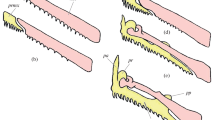Abstract
The jaw mechanism of cichlid fishes is an intricate apparatus with complex force transmission from muscles to environment. The proportions of this apparatus change considerably during growth mainly due to scale effects. In adult fishes, the proportions differ, corresponding with the type of preferred food. In such a complex mechanism, it is very hard to gain insight into the functional meaning of the differences in proportions, unless a biomechanical model is constructed, describing kinematics and force equilibria of the apparatus.
Such a model has been constructed and by means of perturbation analysis anatomical points could be selected of which the positions are very important for the function of biting. These “hot spots” need only small displacements in order to obtain an increase in biting force. By means of a newly developed mathematical technique, it was possible to move the anatomical points in very small steps towards more favourable positions for the function of biting.
In this way, an improved version of an existing not very powerful biting insect feeding species, Haplochromis elegans, was calculated. This calculated version resembles a more powerful biting species Haplochromis nigricans very closely. Also, the functional meaning of the proportional changes during growth of the insect feeding Haplochromis elegans could be evaluated. In both cases compromises could be indicated where functional demands are in conflict with each other on the level of the anatomical design of the jaw mechanism.
Similar content being viewed by others
References
Barel, C.D.N., Witte, F., and van Oijen, M.J.P. (1976). The shape of the skeletal elements in the head of a generalized Haplochromis species: H. elegans Trewavas 1933 (Pisces, Cichlidae).- Neth J Zool 26: 163–265.
Dullemeijer, P. (1956). The functional morphology of the head of the common viper, Vipera berus (L.).- Arch Néerl Zool 11: 386–497.
Dullemeijer, P. (1959). A comparative functional-anatomical study of the heads of some Viperidae.- Morph Jb 99: 881–985.
Dullemeijer, P. (1974). Concepts and approaches in animal morphology. Assen: Van Gorcum & Comp., 264 p.
Greenwood, P.H. (1973). A revision of the genus Haplochromis and related species (Pisces, Cichlidae) from Lake George, Uganda.- Bull Br Mus Nat Hist (Zool) 25: 139–242.
Lakatos, I. (1970). Falsification and the methodology of scientific research programmes.- In I. Lakatos and A. Musgrave, eds., Criticism and the growth of knowledge, 91–196. Cambridge: Cambridge University Press.
McMahon, T.A. (1984). Muscles, reflexes, and locomotion.- Princeton: Princeton University Press, 331 p.
Otten, E. (1981). Vision during growth of a generalized Haplochromis species: H. elegans Trewavas 1933 (Pisces, Cichlidae).- Neth J Zool 31: 650–700.
Otten, E. (1983). The jaw mechanism during growth of a generalized Haplochromis species: H. elegans Trewavas 1933 (Pisces, Cichlidae). Neth J Zool 33: 55–98.
Zweers, G.A. (1979). Explanation of structure by optimization and systemization.- Neth J Zool 29: 418–440.
Author information
Authors and Affiliations
Rights and permissions
About this article
Cite this article
Otten, E. Proportions of the jaw mechanism of cichlid fishes changes and their meaning. Acta Biotheor 34, 207–217 (1985). https://doi.org/10.1007/BF00046785
Issue Date:
DOI: https://doi.org/10.1007/BF00046785




